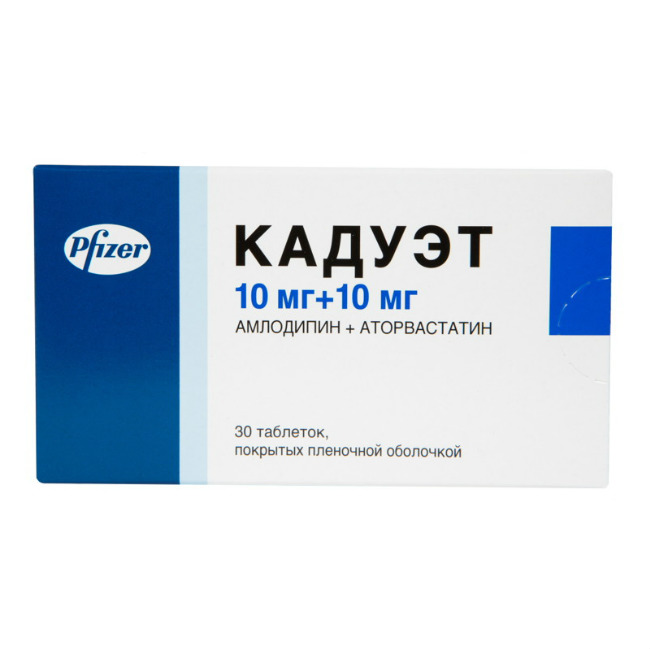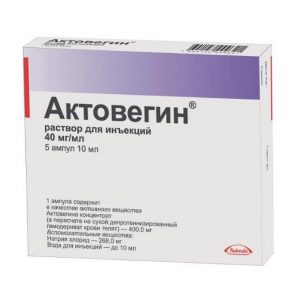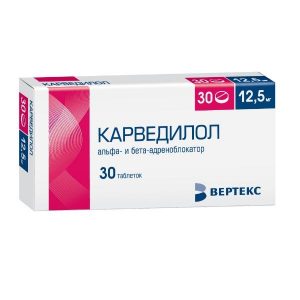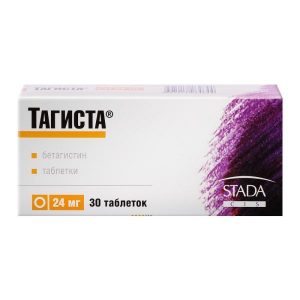Description
Release form
Film-coated tablets.
packaging 30 pcs
Indications
Arterial hypertension with three or more risk factors for the development of cardiovascular events (fatal and nonfatal coronary heart disease, the need for revascularization, fatal and nonfatal myocardial infarction, stroke and transient ischemic attack), with normal or moderately elevated level X Ischemic heart disease.
The drug is used in cases where combination therapy with amlodipine and low doses of atorvastatin is recommended. A combination of Caduet with other antihypertensive and / or antianginal agents is possible.
Kaduet is used in cases where the lipid-lowering diet and other non-pharmacological methods of treating dyslipidemia are ineffective or ineffective.
Contraindications
– active liver disease or persistent increase in liver enzyme activity more than 3 times higher than the norm of unclear etiology
– severe arterial hypotension
– pregnancy
– lactation period (breastfeeding)
– not suitable for women contraceptive methods
– children and adolescents under 18 years of age (efficacy and safety not established)
– hypersensitivity to amlodipine and other derivatives of di hydropyridine, atorvastatin, or any component of Cadouet.
Special instructions
Myalgia has been observed in patients receiving atorvastatin. The diagnosis of myopathy (muscle pain or weakness combined with an increase in CPK activity by more than 10 times compared with VGN) should be assumed in patients with common myalgia, muscle soreness or weakness and / or a marked increase in CPK activity. Patients should immediately consult a doctor if unexplained muscle pain or weakness occurs, especially if they are accompanied by malaise or fever. Therapy with the drug Kaduet should be discontinued in case of a pronounced increase in KFK activity or in the presence of confirmed or suspected myopathy.
The risk of myopathy in the treatment of other drugs of this class increases with the simultaneous use of cyclosporin, derivatives of fibroic acid, erythromycin, nicotinic acid or azole antifungal drugs. Many of these drugs inhibit CYP3A4-mediated metabolism and / or drug transport. It is known that CYP3A4 is the main isoenzyme of the liver involved in the biotransformation of atorvastatin. When prescribing atorvastatin in hypolipidemic doses in combination with fibroic acid derivatives, erythromycin, immunosuppressants, azole antifungal drugs or nicotinic acid, the expected benefit and risk of treatment should be carefully weighed and patients should be regularly observed to detect muscle pain or weakness, especially during the first months of treatment and during the period of increasing the dose of any drug. In such situations, periodic determination of CPK activity can be recommended, although such control does not prevent the development of severe myopathy.
Taking Caduet may cause increased KFK activity. When using atorvastatin, like other drugs of this class, rare cases of rhabdomyolysis with acute renal failure due to myoglobinuria are described. Kaduet therapy should be temporarily discontinued or completely discontinued if there are signs of a possible myopathy or a risk factor for the development of renal failure due to rhabdomyolysis (for example, severe acute infection, hypotension, surgery, trauma, metabolic, endocrine and electrolyte disturbances and uncontrolled seizures). Treatment with amlodipine in an adequate dose to control arterial hypertension can be continued.
Influence on the ability to drive vehicles and control mechanisms
Although the available data on amlodipine and atorvastatin indicate that a combined preparation should not impair the ability to drive and use equipment, caution should be exercised when driving vehicles and operating mechanisms (given the possible development of an excessive reduction HELL, dizziness, fainting).
Composition
1 tab. contains amlodipine 10 mg and atorvastatin 10 mg
excipients: calcium carbonate, croscarmellose sodium, microcrystalline cellulose, pregelatinized starch, polysorbate 80 (tween 80), hyprolysis, silicon dioxide colloidal, magnesium stearate, white film coating Opadryl II white 85 (white Opadryl II white 85 titanium dioxide, macrogol (PEG) 3000, talc)
Dosage and administration
Kaduet is taken orally 1 tablet 1 time / day. at any time, regardless of the meal.
The initial and maintenance doses are selected individually taking into account the effectiveness and tolerability of both components in the treatment of arterial hypertension / angina pectoris and dyslipidemia. The caduet can be prescribed to patients who are already taking one of the components of the drug in monotherapy.
The caduet is used in combination with non-drug therapies, including diet, exercise, weight loss in obese patients, and smoking cessation.
Start treatment with 5/10 mg tablets (amlodipine / atorvastatin, respectively). In patients with arterial hypertension, it is necessary to control blood pressure every 2-4 weeks and, if necessary, 10/10 mg tablets (amlodipine / atorvastatin, respectively) can be transferred to the pill.
In CHD, the recommended dose of amlodipine is 5-10 mg 1 time / day.
Side effects of
In clinical trials, the safety of amlodipine and atorvastatin was studied in patients with a combination of arterial hypertension and dyslipidemia, and no unexpected adverse effects were observed with combination therapy.
Adverse effects were consistent with those previously identified with amlodipine and / or atorvastatin. In general, tolerance to combination therapy was good. Most of the undesirable effects were mild or moderate. In controlled clinical trials, due to undesirable effects or deviations of laboratory parameters, treatment with amlodipine and atorvastatin was discontinued in 5.1% of patients, and placebo in 4.0%.
Amlodipine
Further, the frequency of adverse reactions is understood as: frequent (> 1%), infrequent (<1%), rare (<0.1%), very rare (<0.01%). From the cardiovascular system: often – peripheral edema (ankles and feet), palpitations infrequently – excessive decrease in blood pressure, orthostatic hypotension, vasculitis is rare – the development or worsening of heart failure is very rare – heart rhythm disturbances (including bradycardia, ventricular tachycardia and atrial fibrillation), myocardial infarction, chest pain, migraine. From the musculoskeletal system: infrequently – arthralgia, muscle cramps, myalgia, back pain, arthrosis rarely – myasthenia gravis. From the side of the central nervous system and peripheral nervous system: sensation of heat and flushing of the face, increased fatigue, dizziness, headache, drowsiness infrequently – malaise, fainting, sweating, asthenia, hypesthesia, paresthesia, peripheral neuropathy, tremor, sleeplessness moods, unusual dreams, nervousness, depression, anxiety rarely – convulsions, apathy, agitation very rarely – ataxia, amnesia. From the digestive system: often – abdominal pain, nausea infrequently – vomiting, changes in bowel movements (including constipation, flatulence), dyspepsia, diarrhea, anorexia, dry mouth, thirst rarely – gum hyperplasia, increased appetite very rarely – gastritis, pancreatitis, hyperbilirubinemia, jaundice (usually cholestatic), increased activity of hepatic transaminases, hepatitis. From the hemopoietic system: very rarely – thrombocytopenic purpura, leukopenia, thrombocytopenia. Metabolic disorders: very rarely – hyperglycemia. From the side of the respiratory system: infrequently – shortness of breath, rhinitis very rarely – cough. From the urinary system: infrequent urination, painful urination, nocturia, impotence is very rare – dysuria, polyuria. From the side of the organ of vision: infrequently – visual impairment, diplopia, disturbance of accommodation, xerophthalmia, conjunctivitis, eye pain. From the skin: infrequently – alopecia is rare – dermatitis is very rare – xeroderma, a violation of skin pigmentation. Allergic reactions: infrequently – skin itching, rash very rarely – angioedema, erythema multiforme, urticaria. Other: infrequently – tinnitus, gynecomastia, weight gain / decrease, perversion of taste, chills, nosebleeds very rarely – parosmia, cold sweat. Atorvastatin Usually well tolerated. Adverse reactions are usually mild and transient. Most common adverse reactions (? 1%): From the side of the central nervous system: insomnia, headache, asthenic syndrome. From the digestive system: nausea, diarrhea, abdominal pain, dyspepsia, constipation, flatulence. From the musculoskeletal system: myalgia. Less frequent adverse reactions: From the side of the central nervous system and peripheral nervous system: malaise, dizziness, amnesia, paresthesia, peripheral neuropathy, hypesthesia. From the digestive system: vomiting, anorexia, hepatitis, pancreatitis, cholestatic jaundice. From the musculoskeletal system: back pain, muscle cramps, myositis, myopathy, arthralgia, rhabdomyolysis. Allergic reactions: urticaria, itching, skin rash, anaphylaxis, bullous rash, erythema multiforme, toxic epidermal necrolysis (Lyell’s syndrome), malignant exudative erythema (Stevens-Johnson syndrome). Metabolic disorders: hypoglycemia, hyperglycemia, increased serum CPK, weight gain. From the hematopoietic system: thrombocytopenia. Other: impotence, peripheral edema, chest pain, secondary renal failure, alopecia, tinnitus, fatigue. Overdose There is no evidence of an overdose of the drug. Both amlodipine and atorvastatin actively bind to plasma proteins, so a significant increase in the clearance of the combined drug during hemodialysis is unlikely. Symptoms of an overdose of amlodipine: excessive peripheral vasodilation, leading to reflex tachycardia, and a pronounced and persistent decrease in blood pressure, including with the development of shock and death. Symptoms of an overdose of atorvastatin are not described. Treatment of an overdose of amlodipine: taking activated charcoal immediately or within 2 hours after taking amlodipine at a dose of 10 mg leads to a significant delay in the absorption of the drug. In some cases, gastric lavage may be effective. Clinically significant arterial hypotension caused by an overdose of amlodipine requires active measures aimed at maintaining the function of the cardiovascular system, including monitoring the performance of the heart and lungs, elevated limbs and controlling bcc and urine output. To restore vascular tone and blood pressure, it may be useful to use a vasoconstrictor drug, if there are no contraindications to its purpose, to eliminate the effects of calcium channel blockade – intravenous administration of calcium gluconate. There are no specific agents for the treatment of atorvastatin overdose. In case of an overdose, symptomatic and supportive treatment should be carried out as necessary. Storage Conditions In a dark place at a temperature not exceeding 25 ° C. Expiration 2 years. lekarstvennaja form tablets




